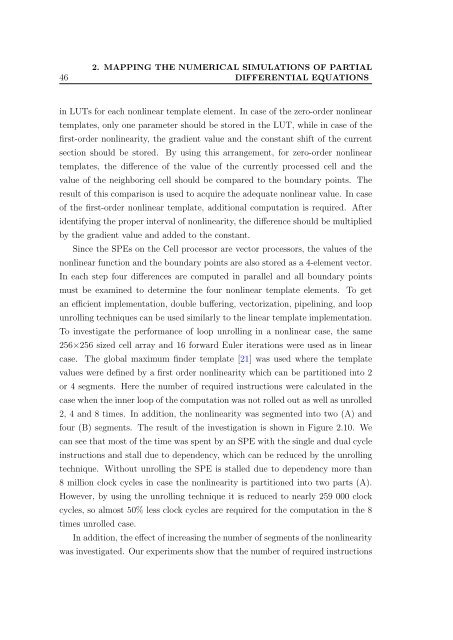PPKE ITK PhD and MPhil Thesis Classes
PPKE ITK PhD and MPhil Thesis Classes
PPKE ITK PhD and MPhil Thesis Classes
You also want an ePaper? Increase the reach of your titles
YUMPU automatically turns print PDFs into web optimized ePapers that Google loves.
46<br />
2. MAPPING THE NUMERICAL SIMULATIONS OF PARTIAL<br />
DIFFERENTIAL EQUATIONS<br />
in LUTs for each nonlinear template element. In case of the zero-order nonlinear<br />
templates, only one parameter should be stored in the LUT, while in case of the<br />
first-order nonlinearity, the gradient value <strong>and</strong> the constant shift of the current<br />
section should be stored. By using this arrangement, for zero-order nonlinear<br />
templates, the difference of the value of the currently processed cell <strong>and</strong> the<br />
value of the neighboring cell should be compared to the boundary points. The<br />
result of this comparison is used to acquire the adequate nonlinear value. In case<br />
of the first-order nonlinear template, additional computation is required. After<br />
identifying the proper interval of nonlinearity, the difference should be multiplied<br />
by the gradient value <strong>and</strong> added to the constant.<br />
Since the SPEs on the Cell processor are vector processors, the values of the<br />
nonlinear function <strong>and</strong> the boundary points are also stored as a 4-element vector.<br />
In each step four differences are computed in parallel <strong>and</strong> all boundary points<br />
must be examined to determine the four nonlinear template elements. To get<br />
an efficient implementation, double buffering, vectorization, pipelining, <strong>and</strong> loop<br />
unrolling techniques can be used similarly to the linear template implementation.<br />
To investigate the performance of loop unrolling in a nonlinear case, the same<br />
256×256 sized cell array <strong>and</strong> 16 forward Euler iterations were used as in linear<br />
case. The global maximum finder template [21] was used where the template<br />
values were defined by a first order nonlinearity which can be partitioned into 2<br />
or 4 segments. Here the number of required instructions were calculated in the<br />
case when the inner loop of the computation was not rolled out as well as unrolled<br />
2, 4 <strong>and</strong> 8 times. In addition, the nonlinearity was segmented into two (A) <strong>and</strong><br />
four (B) segments. The result of the investigation is shown in Figure 2.10. We<br />
can see that most of the time was spent by an SPE with the single <strong>and</strong> dual cycle<br />
instructions <strong>and</strong> stall due to dependency, which can be reduced by the unrolling<br />
technique. Without unrolling the SPE is stalled due to dependency more than<br />
8 million clock cycles in case the nonlinearity is partitioned into two parts (A).<br />
However, by using the unrolling technique it is reduced to nearly 259 000 clock<br />
cycles, so almost 50% less clock cycles are required for the computation in the 8<br />
times unrolled case.<br />
In addition, the effect of increasing the number of segments of the nonlinearity<br />
was investigated. Our experiments show that the number of required instructions






![optika tervezés [Kompatibilitási mód] - Ez itt...](https://img.yumpu.com/45881475/1/190x146/optika-tervezacs-kompatibilitasi-mad-ez-itt.jpg?quality=85)









